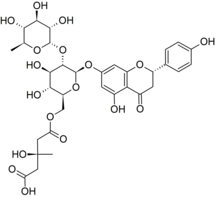Mélitidine
| Mélitidine | |

| |
| Structure de la mélitidine, un flavonoïde. | |
| Identification | |
|---|---|
| Nom UICPA | 5-[[(2R,3S,4S,5R,6S)-3,4-dihydroxy-6-[5-hydroxy-2-(4-hydroxyphenyl)-4-oxo-2,3-dihydrochromen-7-yl]-5-[(2S,3R,4R,5R,6S)-3,4,5-trihydroxy-6-methyloxan-2-yl]oxyoxan-2-yl]methoxy]-3-hydroxy-3-methyl-5-oxopentanoic acid |
| Synonymes |
DTXSID301336366 |
| PubChem | 101485562 |
| SMILES | |
| InChI | |
| Propriétés chimiques | |
| Formule | C33H40O17 |
| Masse molaire[1] | 708,660 5 ± 0,034 3 g/mol C 55,93 %, H 5,69 %, O 38,38 %, 708.7 g/mol |
| Unités du SI et CNTP, sauf indication contraire. | |
| modifier |
|
La mélitidine est un hétéroside de flavanone, le 7-O-néohespéridoside-6″-O-HMG de la naringinine, qui appartient à la famille des diglycosides de flavonoïdes. Elle est présente dans la bergamote (C. bergamia) et le pamplemousse (C. maxima).
Présence chez les agrumes[modifier | modifier le code]
Son niveau dans l'extrait de bergamote est moyen: 8,25 ± 0,93 μmol/g poids sec[2]. La mélitidine est aussi présente dans l'écorce de pamplemousse (C. maxima (L.) Osbeck) fermentée en milieu alcoolisé[3]. On l'extrait par filtrage du jus de bergamote[4], elle est aussi présente dans l'albédo[5].
Les gènes responsables de la biosynthèse de la mélitidine chez le pamplemousse ont été identifiés (2023), l'abondance naturelle de la mélitidine est liée au niveau des acyltransférases spécifiques du substrats amers[6].
Pharmacologie[modifier | modifier le code]
La mélitidine un principe actif anti-cholestérolémique[7] et un antioxydant[8]. Comme anti-cholestérolémique elle se comporte comme une statine, le mécanisme d'action (réduction de l'expression du gène PCSK9 dans les cellules HuH7) a été décrit (2023)[9].
Des travaux italiens (2010) ont cherché une exploitation facile en mettant des extraits secs de peau de bergamote dans des sachets de thé, la température d'infusion de 65 °C donne le meilleur résultat[5].
Notes et références[modifier | modifier le code]
- Masse molaire calculée d’après « Atomic weights of the elements 2007 », sur www.chem.qmul.ac.uk.
- Valentina Spigoni, Pedro Mena, Federica Fantuzzi et Michele Tassotti, « Bioavailability of Bergamot (Citrus bergamia) Flavanones and Biological Activity of Their Circulating Metabolites in Human Pro-Angiogenic Cells », Nutrients, vol. 9, no 12, , p. 1328 (ISSN 2072-6643, PMID 29211032, PMCID 5748778, DOI 10.3390/nu9121328, lire en ligne, consulté le )
- Xiaoju Tian, Ying Liu, Xi Feng et Ashfaque Ahmed Khaskheli, « The effects of alcohol fermentation on the extraction of antioxidant compounds and flavonoids of pomelo peel », LWT, vol. 89, , p. 763–769 (ISSN 0023-6438, DOI 10.1016/j.lwt.2017.11.049, lire en ligne, consulté le )
- (en) René Ruby-Figueroa, Carmela Conidi, Leonardo Di Donna et Alfredo Cassano, « Recovery of bruteridin and melitidin from clarified bergamot juice by membrane operations », Journal of Food Process Engineering, vol. 41, no 7, , e12870 (DOI 10.1111/jfpe.12870, lire en ligne, consulté le )
- Leonardo Di Donna, Giselda Gallucci, Naim Malaj et Elvira Romano, « Recycling of industrial essential oil waste: Brutieridin and Melitidin, two anticholesterolaemic active principles from bergamot albedo », Food Chemistry, vol. 125, no 2, , p. 438–441 (ISSN 0308-8146, DOI 10.1016/j.foodchem.2010.09.025, lire en ligne, consulté le )
- (en) Shuangqian Shen, Shouchuang Wang, Chenkun Yang et Chao Wang, « Elucidation of the melitidin biosynthesis pathway in pummelo », Journal of Integrative Plant Biology, (ISSN 1672-9072 et 1744-7909, DOI 10.1111/jipb.13564, lire en ligne, consulté le )
- (en) Martello Emanuela, Sisci Diego, Dolce Vincenza, Hypocholesterolemic activity of brutieridin and melitidin enriched fraction from bergamot fruit (Citrus bergamia): in vivo and in vitro studies, Catane, Université de Calabre, , 69 p. (lire en ligne)
- Mei Deng, Xuchao Jia, Lihong Dong et Lei Liu, « Structural elucidation of flavonoids from Shatianyu (Citrus grandis L. Osbeck) pulp and screening of key antioxidant components », Food Chemistry, vol. 366, , p. 130605 (ISSN 0308-8146, DOI 10.1016/j.foodchem.2021.130605, lire en ligne, consulté le )
- Irene Ferrarese, Maria Giovanna Lupo, Ilaria Rossi et Stefania Sut, « Bergamot (Citrus bergamia) peel extract as new hypocholesterolemic agent modulating PCSK9 expression », Journal of Functional Foods, vol. 108, , p. 105724 (ISSN 1756-4646, DOI 10.1016/j.jff.2023.105724, lire en ligne, consulté le )
